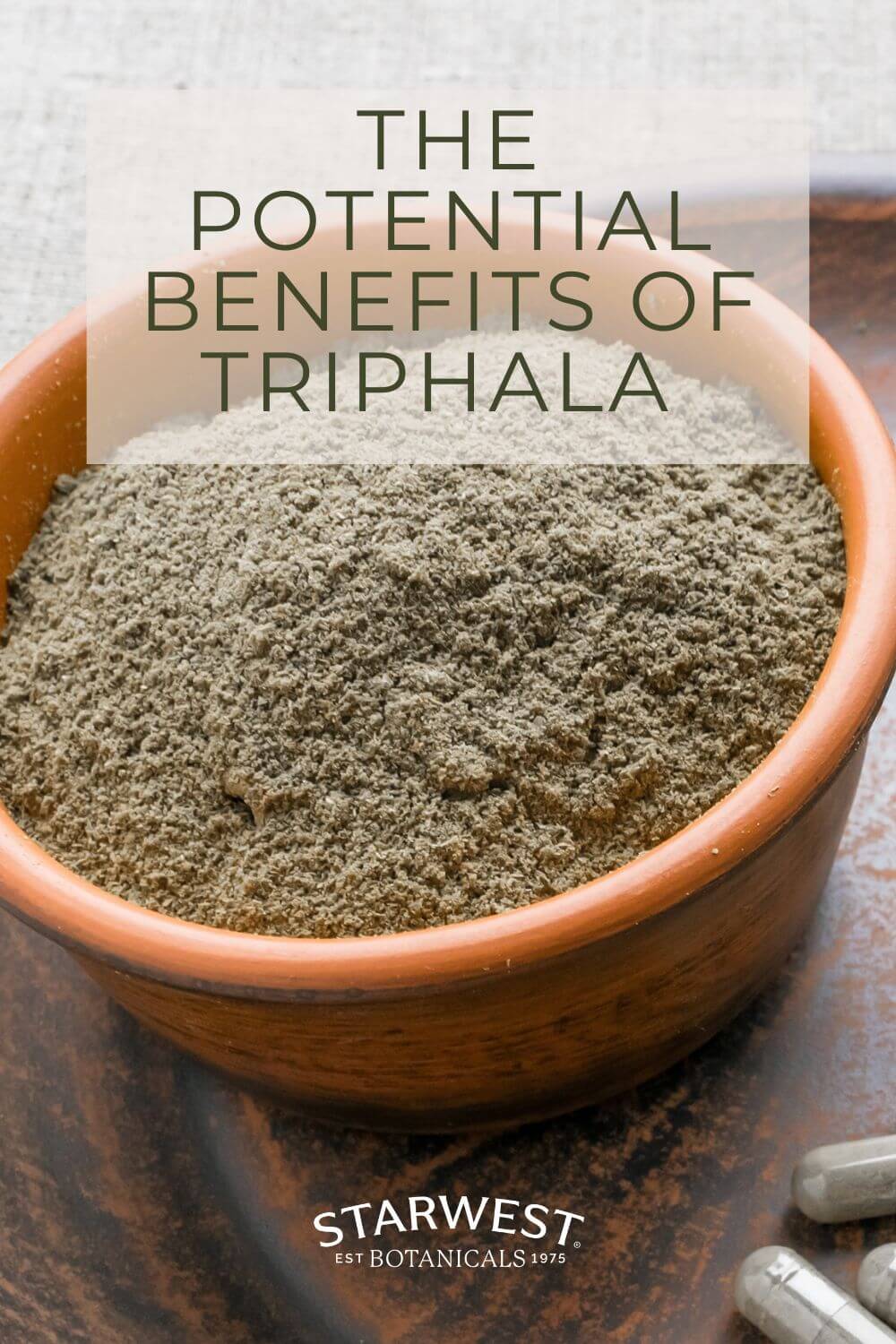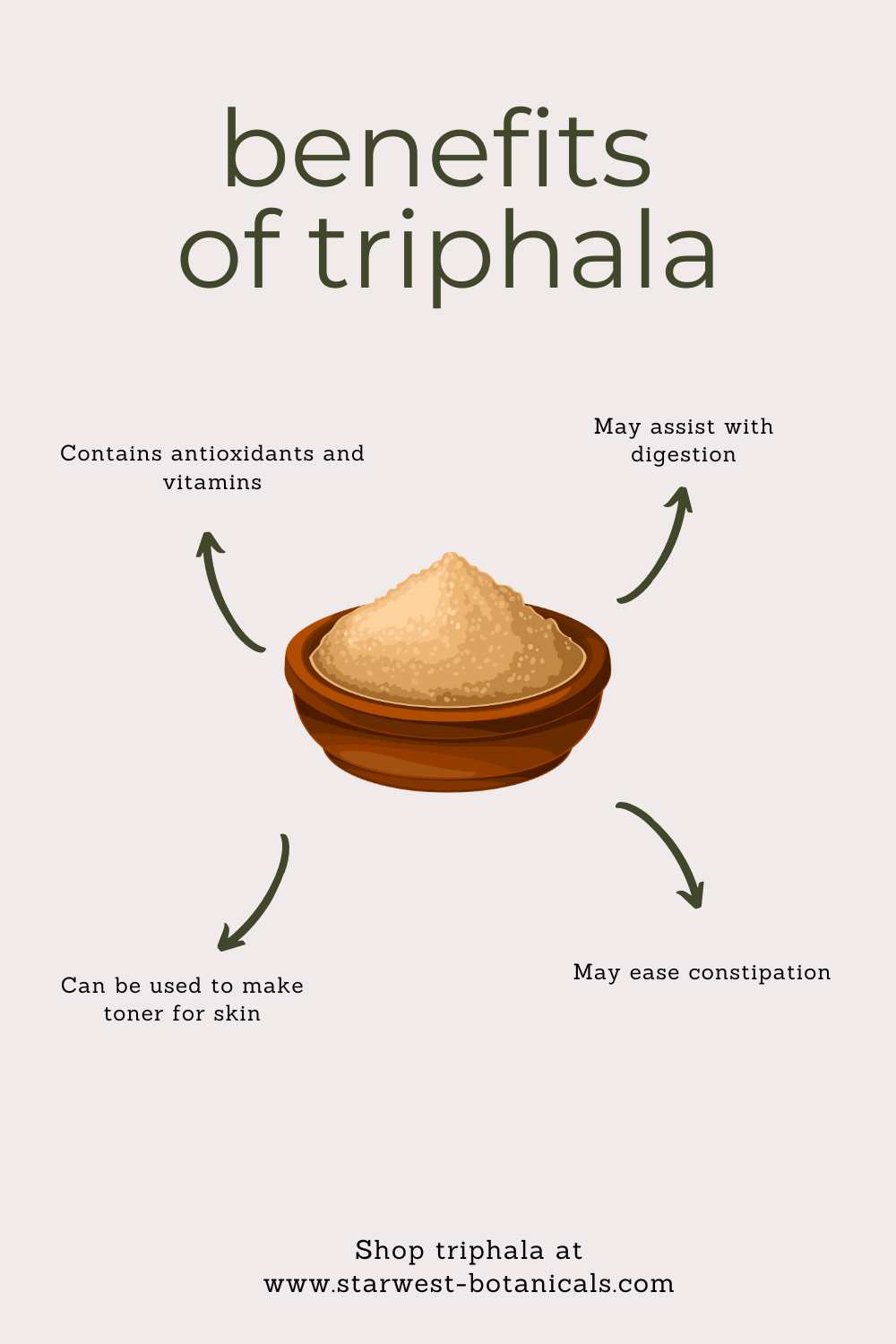The Benefits of Triphala | Starwest Botanicals
Posted by Molly McConnell on 09-13-2023

Triphala is most well-known as a bowel tonic, but what it can offer the body goes far beyond relief from constipation. While it can be excellent for cleansing the system, it also has the ability to offer deep nourishment and rejuvenation to the tissues. In fact, triphala is said to support the body head to toe. Let’s take a deeper look.
Before we dive into the wonderful healing potential of triphala, it’s important to understand where it comes from and what makes it so effective.
ORIGINS OF TRIPHALA
The original understanding of how to use triphala as potent herbal medicine comes from a holistic modality called Ayurveda. Believed to be the oldest system of healing in the world, Ayurveda is distinct in that it emphasizes a model of preventive care that is centered around diet, lifestyle and herbs catered to the individual’s constitution.
Ayurveda reminds us that everything from the earth can act as a medicine or a poison, depending on who you are and what you need, as well as how and when you take it. With this in mind, as you continue to learn about different herbs and remedies, I invite you to tune into your body and remember that more isn’t always better. Notice how your needs change with the seasons, the weather, and the level of stress in your life.
Over thousands of years, Ayurveda has celebrated the ways in which we live in relationship to the world around us including plants. In many ways, modern science is just now catching up with what Ayurveda has been teaching us all along about the healing potential of our natural world.
THE SYNERGISTIC EFFECT
One of the cornerstones of Ayurvedic herbalism is the knowledge that increased potency may arise from combining botanicals in thoughtful formulations, rather than taking them individually or in chemically isolated forms. While triphala is often assumed to be a single herb, it’s actually a classical formulation of three fruits — haritaki, amalaki and bibhitaki. These fruits are in the Indian gooseberry family and offer a very high concentration of vitamin C, among many other vibrant healing compounds. It is believed that these three botanicals have the potential to be more effective when working as a team. This is the power of the synergistic effect that is thought to allow medicinal compounds to go deeper into the tissue.
The name triphala actually translates to the “three fruits” in Sanskrit. Sanskrit is the language of ancient India, which you now know is where the holistic wisdom of Ayurveda was born. Triphala, along with other key herbs for digestion and overall wellness, has been integral to this ancient wisdom for thousands of years and it is a gift to continue having access to it today.

TRIPHALA IN YOUR BODY
When triphala first touches your tongue, you may notice a tightening sensation in your mouth. It’s not quite the same feeling of sourness that makes you pucker and salivate. The mouth almost feels dry for a moment. This is the impact of the astringent taste that triphala is famous for. Astringency is known for an action of toning, tightening and/or squeezing. This means that in addition to using triphala internally to move a bowel movement along, you can also use it topically as a toner on the skin.
While most herbs have a heating or cooling effect, triphala is considered to be neutral, which makes it suitable for many conditions.
In the world of Ayurveda, there are three mind body types (also called doshas) comprised of the energies of elements. These three doshas are called vata, pitta and kapha. Each of the three fruits of triphala acts to balance one of these doshas, making it a formula that can be beneficial to a wide range of constitutions.
THE GIFTS OF TRIPHALA
Triphala has been historically revered for both its cleansing and rejuvenative properties. Most cleansing herbs are rough and scraping on the body and, as a result, can be too harsh when taken over a long period of time. Triphala is unique in that it also helps nourish, restore and rejuvenate, which makes it something that can be taken in a more ongoing way. The cleansing nature of triphala is not only effective, but also gentle relative to other common cleansing herbs.
In addition to working with the digestive system, triphala also works within the circulatory system. Typically, herbs that work within these systems also naturally support the skin. Breakouts can often be a sign of poor digestion, toxic build up, or the body trying to expel impurities or excess doshas through the skin. When the digestive and circulatory systems are flowing appropriately, the skin glows.
Another contributing factor to that healthy glow is the natural antioxidants found in triphala. Antioxidants may actually prevent cellular damage, allowing all of your systems to function more effectively and potentially reducing the risk of diseases related to free-radical damage. Vitamin C is an antioxidant found in triphala. Amalaki, one of the three fruits found in triphala, has about 10 times more vitamin c than an orange - which is a pretty impressive concentration, especially considering how small it is. In addition to Vitamin C, triphala also contains Vitamin A. The combination of these two vitamins allow triphala to act as an immunomodulator.
In addition to supporting a healthy immune response, glowing skin, digestive ease, and circulation, triphala also supports an optimal inflammatory response. It is often used for oral health and even wound care.
WHEN TO TAKE TRIPHALA
One of the most common ways to take triphala is as a nightly tonic to cleanse and rejuvenate the digestive system. One teaspoon is typically a more laxative dose for an adult, while ¼ tsp may be more binding to the stools. For more personalized guidance, meet with an Ayurvedic Practitioner.
WHEN TO AVOID TRIPHALA
While it may be used in the preconception phase, do NOT take triphala while pregnant. Be cautious when using triphala in the presence of dry or cracked lips, because it may be drying for you. Do not take triphala if you are currently taking psyllium husk, as the two together may overwhelm the system by creating too much downard energy.
When you’re ready to learn more about incorporating triphala into your life, check out Four Ways to Use Triphala in Your Daily Routine. Shop Organic Triphala in bulk here.
Bio
Molly McConnell is a Certified Ayurvedic Practitioner who is committed to cultivating collective wellness. Guided by curiosity, embodied listening, and the rhythms of nature, Molly’s approach to Ayurveda is intentional and intersectional. As the cofounder of Cultivate Balance, she supports purpose-oriented people to come home to their bodies and restore resilience through nourishment, ritual, and routine. For a more immersive experience, Connect with Molly 1:1 or check out The Reset for Resilience.
Instagram/Tiktok
Website



